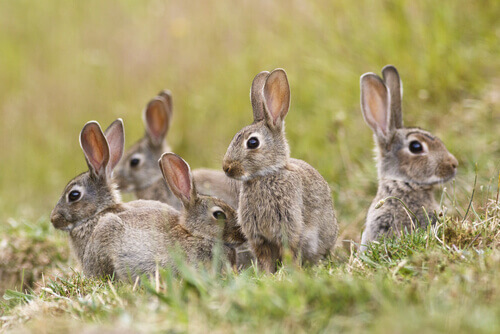What Happened with Australia’s Rabbits?


Written and verified by the vet Eugenio Fernández Suárez
The history of rabbits in Australia is a deadly example of how humans can affect wildlife, and of the havoc invasive species can wreak on our ecosystems.
Invasive species are animals that are introduced into an ecosystem they don’t belong in, which causes big problems. As a result they can displace other species of fauna and flora, threatening the health of the ecosystems where they’re introduced.
Introducing rabbits into Australia: a bad idea
There were no rabbits on the Australian continent until Thomas Austin decided to bring them over at the end of the 18th century. He set 24 rabbits loose on his land with the idea of practicing hunting in his new home.
Rabbits are animals with huge reproductive capacity, and the few pairs of mates that Thomas brought over multiplied extremely quickly. The females go into heat every three weeks; the gestation period is just one month, and they can have litters of up to 14 young. As a consequence this lagomorph reproduced very rapidly in Australia.
Within a few years, rabbits began to sweep through Australian grasslands and agricultural areas. They displaced many species and even caused some to go extinct.

The country had 10 billion rabbits by 1920. The huge amount of grass they ate caused erosion and desertification; in addition the impact on agriculture would cost Australia $350 million per year.
Solutions to Australia’s rabbit problem
The problem was that no one thought of appropriate solutions to the problem at the beginning. One of the main measures taken at the time was to introduce another invasive species: the red fox.
The results were disastrous: the rabbits continued to multiply in the absence of predators, and at the same time the foxes caused havoc among the different marsupials of the continent, who were not used to the presence of this canid.
The foxes preyed especially on birds, who controlled the insect population; together with the impact of the rabbits, this caused a terrible drought in the 1920s. As a result hunters killed thousands of koalas, both because of the famine and because they thought they were the cause of the problem.
Biological warfare against rabbits in Australia
Later, solutions such as poisons, fencing and finally biological weapons were used: Australians decided to introduce one of the most dangerous diseases for rabbits, myxomatosis.
The measure was effective at first and killed off 500 million rabbits. However, the survivors, who were more resistant to the disease, had offspring who inherited this resistance and myxomatosis ended up becoming a simple cold for them.
The next step was to use another disease which affects rabbits greatly; viral hemorrhagic disease. The idea was to do these first experiments on an island, but mosquitoes spread the disease to the mainland. Luckily, the experiment achieved the desired effect; 60% of the country’s rabbit population died off.
Recently, the Australian government chose to release a new strain of this disease, which may be as deadly as Ebola and as contagious as the flu. Although it only affects rabbits, international animal health authorities have called the move irresponsible.
An example of the problem of invasive species
Today it seems that rabbit populations have declined and the health of various native animal populations has improved; many biologists support the thesis that the Australian government’s conservation measures are behind a reduction in rabbit numbers.
However, these Australian experiments are a clear example of how we can’t control nature. Even today there are fears that these viruses will mutate in Australia and one day maybe even reach Europe.
In fact, the diseases experimented with in Australia are responsible for the decline of rabbit populations in Spain. As a result Iberian lynx numbers have also declined due to the loss of their most important prey.
To sum up, the history of rabbits in Australia highlights the danger of bringing species from other ecosystems into new areas. We humans must be careful and respectful when playing God with our fauna.
This text is provided for informational purposes only and does not replace consultation with a professional. If in doubt, consult your specialist.